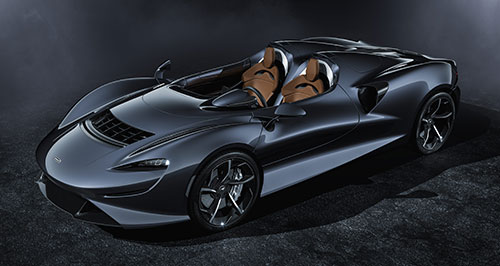Make / Model Search
New models - McLaren - ElvaMcLaren unveils all-new Elva – with windscreen optionalRetro $2.7m Elva roadster celebrates Bruce McLaren’s pioneering 1960s sportscars14 Nov 2019 MORE than three million dollars – once import duties and luxury car tax are added – does not include a windscreen on McLaren’s latest model, the Elva.
The not-insubstantial sum does, however, secure one of the lightest and most powerful road cars yet made by the British supercar specialist, which joins the $1.34m Senna and $3.76m Speedtail in Woking’s top-tier Ultimate Series range.
With production limited to 399 units, the Elva could also provide an alternative for well-heeled enthusiasts and collectors who missed out on the 500 Ferrari Monza SP1 and SP2 speedsters that similarly lack a windscreen.
McLaren secured legal rights to the Elva name for its first open-cockpit model, which is inspired by the superlight 551kg McLaren M1A racer that was designed by Bruce McLaren in the 1960s – featuring plenty of cutting-edge engineering for the era – and produced as customer models in partnership with boutique British sportscar manufacturer Elva Cars.
An official weight figure for the Elva has not yet been announced, but McLaren is already calling it the lightest road car it has produced to date. Regardless, a lack of roof and windows should enable the model to come in well under the 1198kg of the featherweight Senna.
Shared with the Senna is a 4.0-litre twin-turbo V8 with the wick turned up by 12kW to hit 600kW – courtesy of improved charge-cooling and a free-flowing Inconel and titanium exhaust with 3D-printed tailpipe tips – while the Senna’s 800Nm torque peak remains.
As a result, the new roadster is claimed to smash from 0-200km/h a tenth quicker than the Senna, in 6.7 seconds. On the way there, 100km/h has been and gone in less than three seconds.
Protecting Elva drivers from buffeting is a claimed world-first aerodynamic innovation that “channels air through the nose of the Elva to come out of the front clamshell at high velocity ahead of the occupants before being directed up over the cockpit to create a relative ‘bubble’ of calm”.
The Active Air Management System (AAMS) vents air channelled from an intake above the front splitter though a grille on the bonnet that directs the flow through 130 degrees using a network of adjustable carbon-fibre vanes.
It is only activated at higher speeds, when a carbon-fibre deflector rises 150mm from in front of the bonnet vent to create an area of low air pressure.
The system can also be manually disabled by the driver, for example when wearing a helmet during track driving, as the AAMS diverts more air to the charge-coolers and transmission oil coolers located ahead of each front wheel when deactivated.
Also helping dissipate heat are the sintered carbon-ceramic brake discs that McLaren says underpin its most advanced set of stoppers yet, due to titanium calliper pistons that reduce overall system weight by 1kg.
First used on the Senna, the new discs are said to take “significantly longer to produce” than regular carbon-ceramic rotors, resulting in greater strength and thermal conductivity. This enables smaller 390mm units to be used all round, saving weight and reducing ducting requirements, which in turn aids aerodynamics.
The brand’s proprietary hydraulically linked active suspension system has been recalibrated for the Elva’s lightweight design with special springs and valving to go with the retuned electronics. Electro-hydraulic power steering is also deployed to deliver “the purest feedback”.
McLaren describes driving the Elva as an “incredibly immersive and enthralling experience”, providing “unparalleled driver engagement and ultimate driving enjoyment”, owing to the lack of roof, windscreen and windows.
Having an open cockpit and carbon-fibre construction has enabled McLaren to blur the boundaries between outside and in, which according to McLaren Automotive design director Rob Melville creates “a technical sculpture that is as striking as it is remarkable, the exterior flowing into the interior”.
For example, the top part of the doors – McLaren’s lightest yet – flows seamlessly from the exterior to the cockpit, similarly the rear buttresses that form an enveloping structure around the two seats and continues seamlessly into the centre console.
It is a similar story with the dashboard, which plunges away from the driver and passenger as it merges with the Elva’s bonnet and is sculpted around the sides to merge with the doors.
Exposed high-gloss carbon-fibre can be optioned to really showcase this continuation from exterior to interior, as well as various colour tints for this look, along with an unlimited selection of hand-applied paint finishes.
The enclosed section of the cockpit is slick but pared back, with a digital instrument cluster that moves with the steering column and paddle-shifters, a quartet of deeply cowled air vents and a row of buttons for engine start and selecting drive, neutral or reverse on the seven-speed dual-clutch transmission.
Driving mode selectors are on the instrument panel, reachable by the driver without taking their hands off the steering wheel. Almost everything else is run through a new 8.0-inch touchscreen media system that is angled toward the driver on its carbon-fibre arm and enables them to scroll through a carousel of various modes with a vertically mounted rotary dial.
The Elva is not completely impractical, providing space for a couple of helmets beneath a carbon-fibre tonneau at the back. Special treated leather is resistant to the elements – handy in a car with no roof – and a grippy new synthetic material McLaren calls Ultrafabric is offered as an option.
Other options include 18-carat white gold or platinum badges with thin-ply carbon inlay and a 24-carat gold heat shield for the engine bay. The 10-spoke “ultra-lightweight” forged alloy wheels can be swapped out for five-spoke “super-lightweight” items and the Pirelli P Zero tyres can be exchanged for more track-focused P Zero Corsa rubber.  Read more30th of August 2019  McLaren expecting GT to be a hit with customersAll-new McLaren GT supercar to be one of the most popular in British brand’s arsenal30th of August 2019  McLaren GT checks in from $399,995 plus ORCsMore comfortable, road-focused GT supercar to lure in new buyers for McLaren brandAll new modelsMotor industry news |
|



 Alfa Romeo
Alfa Romeo Abarth
Abarth Audi
Audi Aston Martin
Aston Martin BMW
BMW Bentley
Bentley Ferrari
Ferrari Chevrolet
Chevrolet Ford
Ford Fiat
Fiat GWM
GWM Foton
Foton Hyundai
Hyundai Honda
Honda Jaguar
Jaguar Isuzu
Isuzu Kia
Kia Jeep
Jeep Land Rover
Land Rover Lamborghini
Lamborghini Maserati
Maserati Lexus
Lexus McLaren
McLaren Mazda
Mazda Mercedes-Benz
Mercedes-Benz Mitsubishi
Mitsubishi Mini
Mini Peugeot
Peugeot Nissan
Nissan Ram
Ram Porsche
Porsche Rolls-Royce
Rolls-Royce Smart
Smart Skoda
Skoda Suzuki
Suzuki Subaru
Subaru Toyota
Toyota Tesla
Tesla Volvo
Volvo Zeekr
Zeekr







Facebook Twitter Instagram